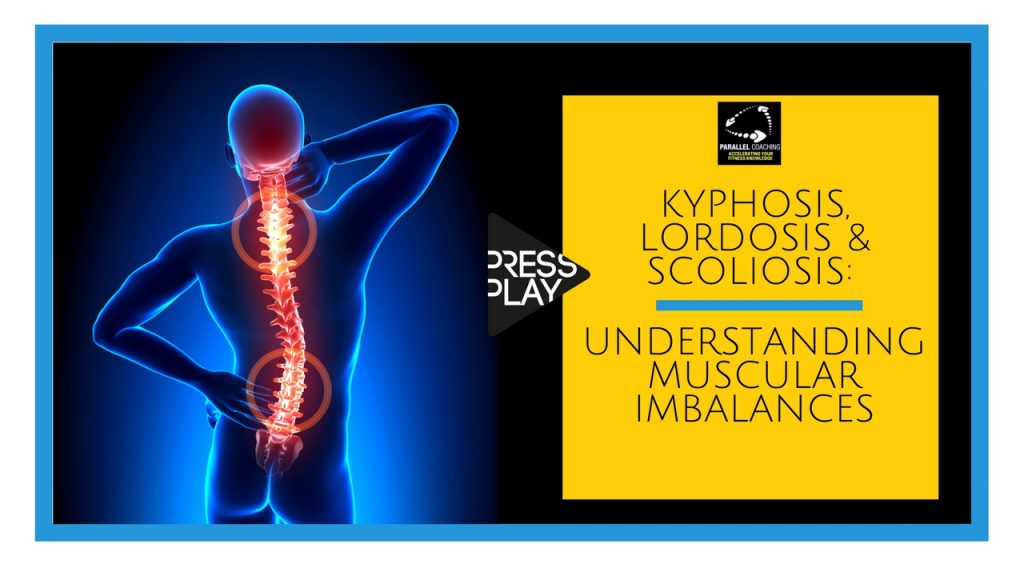This 10-minute video takes you through all 3 of the major muscular imbalances including, Kyphosis, Lordosis and Scoliosis
It will also teach you why some muscles get tighter than others and what to do about it.
You’ll discover:
- Why it is important to understand muscular imbalances
- 10-minute video explaining key muscular imbalances
- What you need to know for your level 2 and 3 anatomy exam
- What is Kyphosis
- What is Lordosis
- What is Scoliosis
- How to learn with simplicity for the rest of the modules
- Three Example Mock Questions about muscular imbalances
Why it is important to understand muscular imbalances
Understanding the muscular imbalances of the body is crucial for both the Level 2 and Level 3 anatomy and physiology exam.
However, you will also use this info as a qualified FitPro, looking out for postural compensations when working with your clients. Spotting these compensations will help you implement corrective exercises, activate weak muscles and stretch the tight muscles.
This will result in a reduced risk of injury for your client, and improve their performance and technique throughout their workouts.
10-minute video explaining key muscular imbalances:
What you need to know for your level 3 anatomy exam
Understanding muscular imbalances is one of eight sections of the Level 3 Anatomy and Physiology exam.
Knowing the key facts about muscular imbalances is crucial, as you can expect 3 to 5 exam questions relating to this in the typical Level 3 anatomy exam.
What is Kyphosis?
Kyphosis or “Kyphotic posture” occurs in the thoracic spine and is an exaggerated concave curve in the sagittal plane.
It is characterised as looking like a hunch-back position and often occurs as a result of tight chest muscles, and weaker mid-back muscles.
What is Lordosis?
Lordosis or “Lordotic posture” occurs in the LUMBAR spine and is an exaggerated convex curve in the sagittal plane.
It is characterized as looking like an exaggerated arch in the low back, often with an anterior tilt of the pelvis. This is often linked to tight hip flexors and low back muscles, and weaker glutes and core activation.
What is Scoliosis?
Scoliosis or “scoliotic posture” occurs in any part of the spine and is an exaggerated C or S shape curve in the frontal plane. You can see this best from the back of the body.
It is characterized as a sideways shift of weight, often showing as one hip higher than another and the opposite shoulder also raised.
In summary
- You must know about Kyphosis, Lordosis, and Scoliosis
- & understand muscle imbalances and how they affect the posture
- These are the main compensations and are likely to be asked as part of your level 3 anatomy and physiology exam.
- This video is taken from our level 3 revision Bootcamp;
- Here’s what Karen had to say about the A&P Revision Bootcamp 👇 👇 👇
Fantastic content that is easy to use and helps breakdown complex subjects in to a easy to learn format. The team are Super professional yet so friendly and engaging. I look forward to my daily questions and videos. Keep up the amazing work
Karen Bushnell
Test your knowledge with today’s mock questions:
[NOTE: The answers are below the 3rd question]
1. Which compensation only occurs in the thoracic vertebrae?
A. Kyphosis
B. Lordosis
C. Scoliosis
D. Fibrosis
2. Which muscles are likely to be tight during a lordotic posture?
A. Glutes
B. Hip Flexors
C. Core
D. Chest
3. Which Postural Compensation features a shift of vertebrae in the frontal plane?
A. Kyphosis
B. Lordosis
C. Scoliosis
D. Fibrosis
What’s the CORRECT answer?
Answers to the mock questions are :
Question 1= A, Question 2 = B, Question 3 = C
Download Hundreds of Mock Questions For Free
If you want more mock questions like this, then you can download more Free Mock Questions: DOWNLOAD NOW
Need More Help with your Level 3 Anatomy Revision?
or Trainee FITPROS Taking Their L3 Anatomy & Physiology Exam.
Learn, Revise & Pass Your Level 3 Anatomy & Physiology Exam In Under 10-hours
(Without Having To Spend Hours Revising Or Feeling Overwhelmed)
If you want to get your revision structured, learn everything you need to know and feel confident on exam day, then click the link below:
https://courses.parallelcoaching.co.uk/products/level-3-anatomy–physiology-revision-bootcamp

Dedicated to More
Hayley “Muscular Imbalances” Bergman
Parallel Coaching
P.S. You can also find us on the following platforms:
Instagram: Follow Now
Facebook: Like Our Page
Twitter: Tweet Us
YouTube: Subscribe Here
More Posture Blogs: HERE

